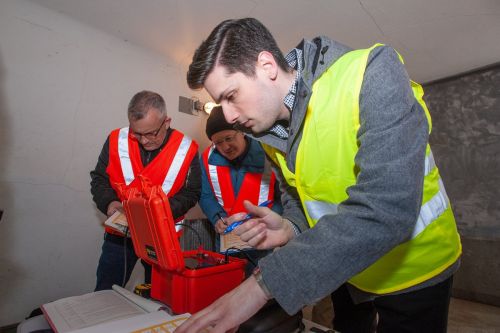
Alex Glaser, left, and Eric Lepowsky, right, participating an exercise led by the UN Institute for Disarmament Research. They are also part of a team building robots that could help locate nuclear weapons. Photo by the UN Institute for Disarmament Research.
Raphael Rosen, Princeton Plasma Physics Laboratory
June 21, 2023
Ensuring compliance with nuclear arms agreements can be difficult and dangerous work, with inspectors hunting for warheads in remote locations. To help, researchers at Princeton have developed a robot that can detect the source of nuclear radiation and find hidden weapons.
The key innovation takes the form of a robot standing almost three feet high, appearing as an extra-tall, extra-wide, silvery soda can mounted on crab-walking treads. The device was originally developed and tested in 2019 by Robert Goldston, professor of astrophysical sciences and former director of the U.S. Department of Energy’s Princeton Plasma Physics Laboratory (PPPL), and Alexander Glaser, associate professor of mechanical and aerospace engineering. This mobile device, perhaps unaccompanied by humans, could help verify compliance with nuclear arms control agreements.
The new version of the robot can determine whether there is a nearby source of neutrons — particles from the nucleus of an atom — and can uniquely determine the direction the neutrons are coming from and the intensity of their source. Detection of these sub-atomic particles could help identify and count nuclear warheads.
The device, called the N-SpecDir Bot, would be programmed only to look for particular materials, rather than conduct a general search of a particular area — a quality that could help persuade countries to allow its use in their territory. “The core idea is that the only information saved and taken from a site would be about a neutron source,” said Eric Lepowsky, a fourth-year graduate student in Princeton’s mechanical and aerospace engineering department and lead author of the paper reporting the results in Nuclear Instruments and Methods in Physics Research.

Another advantage would enable robot inspectors to look for nuclear material in a consistent manner. “A robot is less error-prone, since it doesn’t get tired,” said Moritz Kütt, a contributing author, visiting research collaborator at the Princeton Program on Science and Global Security. “Its judgement is the same whether it’s early in the morning or late in the evening.”
The findings pertain to the first 2019 results and confirm that the robot operates as designed. Lepowsky and colleagues recently upgraded the robot by increasing the number of sensors from three to six, allowing the device to get the same measurements as before in half the time. The new sensors also provide a better sense of the direction toward a neutron source.
The researchers designed the robot for a time when the international community is able to collaborate to reduce common threats. “You could imagine a future agreement with a country that shrinks nuclear arsenals; such an agreement would require tools that would let you determine whether a particular facility was clean,” Lepowsky said. “Our device is such a tool, ready to use when politics and international affairs have aligned.”
Lepowsky found himself drawn to this project because it combines several different fields. “It involves solving a real problem by drawing from concepts in robotics, signal processing, and radiation detection,” he said. “This is a problem that everyone should be concerned about.”
In the future, the researchers hope to test the robot in more realistic scenarios. “We would like to use this technology to measure real sources of interest, whether a mockup warhead or some form of uranium,” Lepowsky said.
The paper, "Experimental demonstration and modeling of a robotic neutron detector with spectral and directional sensitivity for treaty verification" was published October 11, 2022 in Nuclear Instruments and Methods in Physics Research. In addition to Goldston, Glaser, Lepowsky and Kütt, coauthors include Soha Aslam from Princeton University, Henry Fetsch from PPPL, and Steven Snell from Cornell University. The research was supported by the National Science Foundation, the Department of Energy (DOE), and the DOE’s National Nuclear Security Administration.
This story is adapted from the Princeton Plasma Physics Laboratory website.